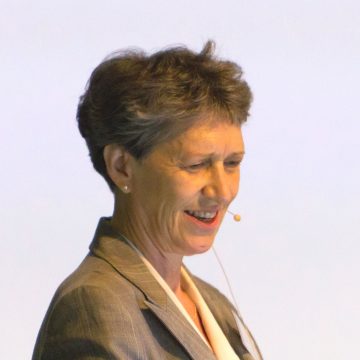
細胞生物学研究
Susan Gasser
特定教授
Nuclear organization Chromatin modifications DNA repair Transcriptional silencing Chromosome organization
略歴
Prof. Susan M. Gasser completed her BA at the University of Chicago with an Honors thesis in Biophysics, and completed her PhD at the University of Basel in Biochemistry in 1982. She studied chromatin and chromosome organization in budding yeast, combining genetics, microscopy and biochemical approaches at the Swiss Institute for Experimental Cancer Research (ISREC) in Lausanne and as professor of Molecular Biology at the University of Geneva. From 2004 – 2019, she was the Director of the Friedrich Miescher Institute for Biomedical Research, where she also led and continues to lead a research group. She also holds a Professorship in Molecular Biology at the University of Basel. Susan Gasser studies the functional impact of the spatial packaging of chromatin, both in the interphase nucleus and with respect to heterochromatin regulation. Her group is interested in how this contributes to and maintains heritable patterns of gene expression. The Gasser laboratory has optimized live imaging techniques to pioneer the analysis of chromatin dynamics with time-lapse fluorescence imaging, particularly during DNA repair. She was elected to the Académie de France, EMBO, AAAS and the Swiss Academy of Medical Sciences, and received the INSERM International Prize in 2011, the FEBS | EMBO Women in Science Award in 2012, the Weizmann Institute Women in Science award in 2013, and two honorary doctorates from the Universities of Lausanne, Switzerland and the Charles University of Prague.
WRHIへの期待
My expectations are two-fold. First I hope to expand the international impact of research on chromatin modifications and their role in nuclear organization. Secondly I hope to promote women in scientific careers. I also am very experienced in mentoring young scientists and helping to create creative and supportive research environments. I led a successful research institute in Basel for 15 years and thus bring leadership experience to Tokyo Tech.
研究プロジェクト
-
The targeting H3K9me domains: how do the HMTs know where to go ?
-
What role does heterochromatin and lamin association play in differentiated cell integrity (especially muscle) ?
-
Is heterochromatin affected by stress ? Is our genome primed to deal with stress through epigenetic changes provoked by the stress response?
-
How does chromatin structure change upon genotoxic insult ?
-
Does the drop in nucleosomal density affect repair efficiency ? How ?
-
Can we manipulate homologous recombination rates by transient reduction in histone levels in mammalian cells ?
| 2020- |
東京工業大学科学技術創成研究院 特定教授 |
|---|---|
| 2019- |
Group leader, Friedrich Miescher Institute for Biomedical Research |
| 2004-2019 |
Director, Friedrich Miescher Institute for Biomedical Research |
| 2004- |
Professor, Molecular Biology, University of Basel |
| 2001-2004 |
Professor, Molecular Biology, University of Geneva |
| 1986-2001 |
Jr then Sr group leader, Swiss Institute for Exp. Cancer Research (ISREC) |
| 2016 |
Lee Hartwell Award, Genetics Society of America |
|---|---|
| 2013 |
Weizmann Institute Women in Science Award, Israel |
| 2020 |
Cheblal, A., Challa, K., Seeber, A., Shimada, K., Yoshida, H., Ferreira, H.C., Amitai, A., and Gasser, S.M. (2020) DNA damage-induced histone depletion enhances double-strand break repair independently of local break movement. Molecular Cell, in press. |
|---|---|
| 2017 |
Hauer, M.H., Seeber, A., Singh, V., Thierry, R., Sack, R., Amitai, A., Kryzhanovska, M., Eglinger, J., Holcman, D., Owen-Hughes, T. and Gasser, S.M. (2017) Histone degradation in response to DNA damage enhances chromatin dynamics and recombination rates. |
| 2016 |
Zeller, P., Padeken, J., van Schendel, R., Kalck, V., Tijsterman, M. and Gasser, S.M. (2016) |
| 2015 |
Gonzalez-Sandoval, A., Towbin, B.D., Kalck, V., Cabianca, D.S., Gaidatzis, D., Hauer, M.H., Geng, L., Wang, L., Yang, T., Wang,. X., Zhao, K. and Gasser, S.M. (2015) Perinuclear Anchoring of H3K9-Methylated Chromatin Stabilizes Induced Cell Fate in C. elegans embryos. Cell, 163, 1333 – 1347. |
| 2012 |
Towbin, B.D., González-Aguilera, C., Sack, R., Gaidatzis, D., Kalck, V., Meister, P., Askjaer, P. and Gasser, S.M. (2012) Step-Wise Methylation of Histone H3K9 Positions Heterochromatin at the Nuclear Periphery. Cell 150, 934 – 947. |
| 2008 |
Nagai, S., Dubrana, K., Tsai-Pflugfelder., M., Davidson, M.B., Roberts, T.M., Brown, G.W., Varela, E., Hediger, F., Gasser, S.M.* and Krogan, N.J. (2008) Functional Targeting of DNA Damage to a Nuclear Pore-associated SUMO-dependent Ubiquitin ligase. *corresponding author Science, 322, 597 – 602. |
| 2006 |
Taddei, A., Van Houwe, G., Hediger, F., Kalck, V., Cubizolles, F., Schober, H. and Gasser, S.M. (2006). Nuclear pore association confers optimal expression levels for an inducible yeast gene. Nature, 441, 774 – 778. |
| 2004 |
van Attikum, H., Fritsch, O., Hohn, B. and Gasser, S.M. (2004) INO80 recruitment by H2A phosphorylation links ATP-dependent chromatin remodeling with DNA double-strand break repair. Cell, 119, 777 – 788. |
| 2001 |
Heun, P., Laroche, T., Shimada, K., Furrer, P., and Gasser, S.M. (2001) |
| 1996 |
Gotta, M., Laroche, T., Formenton, A., Maillet, L., Scherthan, H. and Gasser, S.M. (1996) The clustering of telomeres and colocalization with Rap1, Sir3 and Sir4 proteins in wild-type S. cerevisiae. J. Cell Biology, 134, 1349 – 1363. |
| 1995 |
Hecht, A., Laroche, T., Strahl-Bolsinger, S., Gasser, S.M. and Grunstein, M. (1995) Histone H3 and H4 N-termini interact with SIR3 and SIR4 proteins: a molecular model for the formation heterochromatin in yeast. Cell, 80, 583 – 592. |
| 1993 |
Palladino, F., Laroche, T., Gilson, E., Axelrod, A., Pillus, L. and Gasser, S.M. (1993) SIR3 and SIR4 proteins are required for the positioning and integrity of yeast telomeres Cell, 75, 543 – 555 |
